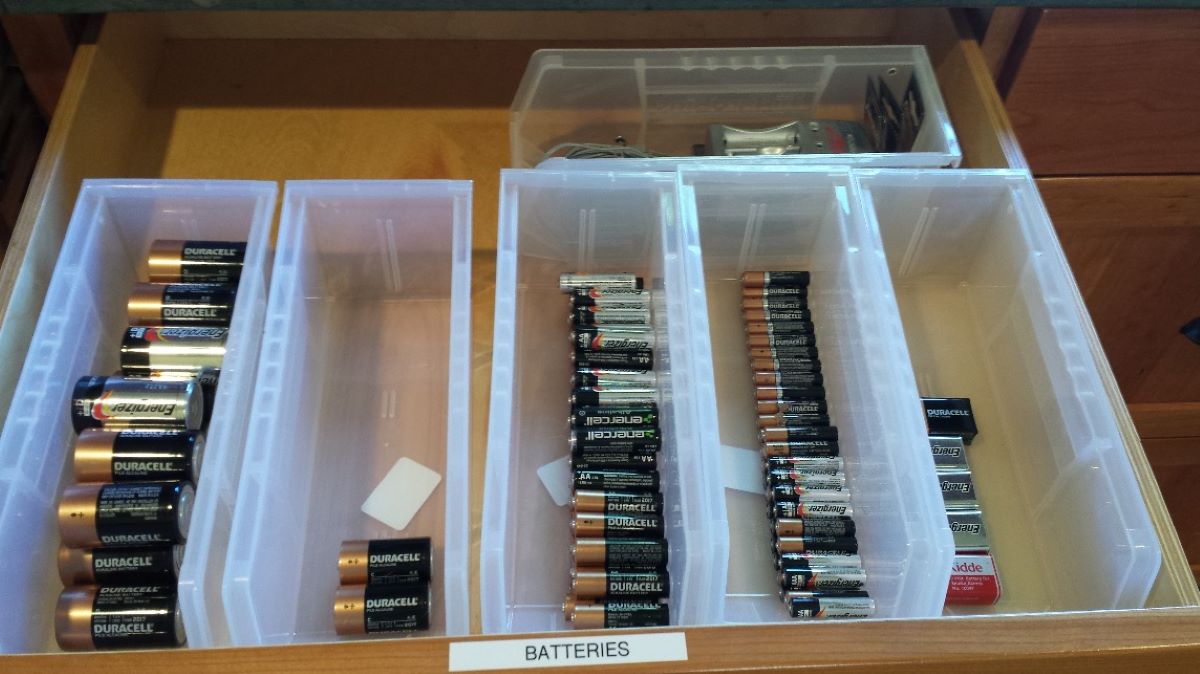

Articles
How To Store Rechargeable Batteries
Modified: December 7, 2023
Learn the best ways to store and maintain rechargeable batteries in this informative guide. Read our articles for expert tips and advice.
(Many of the links in this article redirect to a specific reviewed product. Your purchase of these products through affiliate links helps to generate commission for Storables.com, at no extra cost. Learn more)
Introduction
Rechargeable batteries have become increasingly popular due to their cost-effectiveness and eco-friendliness. Unlike single-use disposable batteries, rechargeable batteries provide a more sustainable and long-term solution for powering various electronic devices, such as smartphones, laptops, cameras, and toys. However, proper storage and maintenance are crucial to ensure their longevity and optimal performance.
In this article, we will discuss the importance of storing rechargeable batteries correctly and provide practical tips to help you extend their lifespan. Whether you have NiMH (Nickel-Metal Hydride) batteries, Li-ion (Lithium-ion) batteries, or Li-po (Lithium Polymer) batteries, implementing these storage methods will help you get the most out of your rechargeable batteries.
Key Takeaways:
- Properly storing rechargeable batteries in a cool, dry location and keeping them in their original packaging or dedicated cases helps maintain their performance and longevity. Regularly checking charge levels and exercising batteries before storage are essential practices to maximize their lifespan.
- Following safety guidelines, such as avoiding mixing battery types and preventing short circuits, is crucial for proper battery storage. Avoiding prolonged storage without usage or maintenance and consulting manufacturer guidelines are key to preserving rechargeable batteries and contributing to a sustainable lifestyle.
Understanding Rechargeable Batteries
Before diving into the storage methods, it’s essential to have a basic understanding of rechargeable batteries and how they differ from disposable batteries. Unlike disposable batteries which are designed for single-use and are typically discarded once depleted, rechargeable batteries can be used multiple times, making them a more sustainable option.
Rechargeable batteries are commonly available in different chemistries, such as Nickel-Metal Hydride (NiMH), Lithium-ion (Li-ion), and Lithium Polymer (Li-po). Each chemistry has its specific advantages and considerations. For instance, NiMH batteries are known for their high capacity and ability to hold charge for extended periods. Li-ion batteries, on the other hand, offer a higher energy density and are commonly used in portable electronic devices like laptops and smartphones.
It’s important to consult the manufacturer’s guidelines to understand the specific characteristics of the rechargeable batteries you own. This information will help you determine the most suitable storage methods and handling precautions to ensure their longevity.
Additionally, it’s crucial to handle rechargeable batteries with care to prevent any damage or potential hazards. Avoid exposing them to extreme temperatures, moisture, or physical impacts, as these factors can affect their performance and safety.
Now that we have a basic understanding of rechargeable batteries, let’s explore the best practices for storing them to maximize their lifespan and maintain their performance.
Choosing the Right Storage Method
When it comes to storing rechargeable batteries, choosing the right storage method is paramount. Proper storage will help preserve their charge and prevent any potential damage.
One of the key considerations is to store rechargeable batteries in a cool and dry location. High temperatures can accelerate the self-discharge rate of batteries, leading to a decrease in their overall capacity. Therefore, it’s important to avoid storing batteries in areas exposed to extreme heat, such as near heaters, stoves, or direct sunlight. Instead, opt for a cool and dry spot, such as a drawer or a closet, where the temperature remains relatively stable.
Another important aspect of storage is keeping batteries in their manufacturer’s packaging. The packaging is designed to protect the batteries from moisture, dust, and other environmental factors. If the original packaging is damaged or misplaced, consider investing in battery storage cases or holders, which provide a safe and organized solution. These cases are designed with individual compartments to prevent batteries from touching one another, which can cause short circuits or accidental discharge.
Labeling and organizing rechargeable batteries is also crucial for easy retrieval. Properly labeling the batteries with relevant information, such as their chemistry type and date of purchase, can help you keep track of their usage and determine their remaining lifespan. Additionally, organizing them in a designated storage container or drawer will ensure that they are easily accessible when needed.
Lastly, it’s essential to avoid storing rechargeable batteries near flammable materials or in areas with high humidity. Exposure to moisture or flammable substances can lead to corrosion, leakage, or even the risk of fire.
By implementing these storage methods, you can ensure that your rechargeable batteries are safely stored and ready to use whenever needed. In the next sections, we will further discuss specific guidelines for temperature control, checking battery charge levels, and exercising batteries before storage.
Storing Rechargeable Batteries in a Cool and Dry Location
One of the most crucial aspects of properly storing rechargeable batteries is to ensure they are kept in a cool and dry location. Heat and humidity can have detrimental effects on battery performance and overall lifespan.
High temperatures can accelerate the self-discharge rate of batteries, causing them to lose their charge even when not in use. This can result in a significant reduction in their capacity over time. To avoid this, it is important to store rechargeable batteries in a cool environment. Ideally, the temperature should be between 15°C to 25°C (59°F to 77°F).
Avoid storing rechargeable batteries near heat sources such as heaters, stoves, or direct sunlight. These heat sources can increase the ambient temperature around the batteries, leading to faster self-discharge and potential damage. Instead, choose a cool and dry spot for storage, such as a drawer or a closet.
Humidity is another factor to consider when storing rechargeable batteries. Moisture can seep into the batteries and cause corrosion, which can lead to leakage and reduced performance. To prevent this, it is recommended to store batteries in a dry environment with low humidity levels.
Protecting the batteries from moisture is especially important if you live in a humid climate or if you plan to store the batteries for an extended period. Consider using airtight containers or storage bags to further safeguard them from any potential moisture exposure.
By storing rechargeable batteries in a cool and dry location, you can prolong their lifespan and ensure they maintain their optimal performance. In the next sections, we will discuss additional tips for storing batteries, such as keeping them in their original packaging and regularly checking their charge levels.
Keeping Batteries in the Manufacturer’s Packaging
When it comes to storing rechargeable batteries, one of the best practices is to keep them in their original manufacturer’s packaging. The packaging is specifically designed to protect the batteries from external factors and maintain their quality over time.
The original packaging provides a secure and protective barrier against moisture, dust, and other environmental elements that can potentially damage the batteries. It prevents any accidental contact between the battery terminals and conductive materials, which could result in short circuits or discharge.
If the original packaging is no longer available or gets damaged, it is recommended to invest in battery storage cases or holders. These cases provide a dedicated space for each battery, preventing them from touching each other. This reduces the risk of accidental discharge and protects the batteries from potential damage, such as scratches or dents.
Battery storage cases are available in various sizes and designs, making it easy to find one that suits your needs. Look for cases that offer individual compartments or slots to keep the batteries securely separated and organized.
Additionally, some battery storage cases also feature labels or color-coded indicators, allowing you to easily identify the charge level or the battery’s remaining lifespan. This can be particularly useful when you have multiple rechargeable batteries of the same type.
By keeping batteries in their original packaging or using dedicated storage cases, you can ensure that they are protected from external elements, organized, and readily available when needed. In the next sections, we will explore further tips for labeling and organizing batteries for easy retrieval.
Read more: How To Recharge AA Batteries In Freezer
Labeling and Organizing Batteries for Easy Retrieval
Properly labeling and organizing rechargeable batteries is essential for easy retrieval and efficient management. When you have multiple batteries of different types or charge levels, it can be challenging to keep track of their usage and determine which ones are ready to use.
One effective way to overcome this challenge is to label your batteries with relevant information. This can include details such as the battery chemistry type (NiMH, Li-ion, etc.), the date of purchase, or any other specific information that is important to you.
Labeling your batteries not only helps you identify them quickly but also gives you an idea of their remaining lifespan. For example, if you have a set of rechargeable batteries that were purchased at different times, you can prioritize using the older ones first to ensure they are properly utilized.
In addition to labeling, organizing your batteries in a systematic manner is crucial for easy retrieval. Consider using storage containers, organizers, or drawers with separate compartments for each battery. This will prevent them from getting mixed up or becoming disorganized over time.
Another helpful tip is to group your batteries according to their charge levels. You can use separate compartments or labels to distinguish between fully charged batteries, partially charged batteries, and batteries that need to be charged.
Color-coded cases or labels can also be useful in quickly identifying the charge status of the batteries. Assigning different colors to different charge levels or battery types allows for easy visual recognition and helps you locate the batteries you need without hassle.
By labeling and organizing your batteries, you can save time and effort when searching for the right ones. Furthermore, it ensures that batteries are used in a fair rotation, preventing some from being overused while others are left unused.
In the following sections, we will discuss additional tips for battery storage, such as avoiding extreme temperatures and regularly checking battery charge levels.
Store rechargeable batteries in a cool, dry place at room temperature. Avoid extreme heat or cold, as it can reduce the battery’s performance and lifespan. Keep them in a plastic or metal container to prevent contact with metal objects.
Avoiding Extreme Temperatures
Extreme temperatures can have a significant impact on the performance and lifespan of rechargeable batteries. It is crucial to avoid exposing batteries to both high and low temperatures to ensure their optimal functioning.
When batteries are exposed to high temperatures, it can lead to increased self-discharge and a reduction in overall capacity. Heat causes the battery’s chemical reactions to occur more rapidly, resulting in a faster depletion of charge. This can result in decreased battery life and performance over time.
Similarly, extremely cold temperatures can also negatively affect battery performance. Cold temperatures can cause the battery’s internal resistance to increase, reducing its ability to deliver power efficiently. This can result in decreased voltage output and diminished overall performance.
To avoid extreme temperatures, it is recommended to store rechargeable batteries in a cool and dry location, as discussed earlier. Avoid storing batteries near sources of heat such as heaters, ovens, or direct sunlight. Additionally, keep batteries away from areas with freezing temperatures, such as your car’s glove compartment during winter.
When using electronic devices in extreme temperature conditions, be aware that this can also impact battery performance. For example, using a smartphone in extremely cold weather can cause the battery to drain faster than usual. In such cases, it is advisable to keep your device warm by storing it in an interior pocket or an insulated case.
If you need to transport rechargeable batteries, especially for outdoor activities or travel, consider using a protective case or bag to shield them from extreme temperatures. Insulated pouches or cases with temperature-regulating properties can help maintain a more stable temperature for the batteries.
By avoiding exposure to extreme temperatures, you can help prolong the lifespan of your rechargeable batteries and ensure they continue to perform at their best. In the next sections, we will discuss the importance of regularly checking battery charge levels and why it’s beneficial to exercise batteries before storage.
Regularly Checking Battery Charge Levels
Regularly checking the charge levels of your rechargeable batteries is an important practice to ensure they are ready for use when needed. By monitoring the charge levels, you can avoid any unpleasant surprises of finding a dead or low-powered battery when you need it the most.
Some rechargeable batteries come with built-in charge indicators, displaying the current charge status. If your batteries have this feature, simply refer to the indicator to determine their charge level. Green is usually indicative of a full charge, while red or blinking lights indicate a lower charge.
If your batteries do not have built-in charge indicators, you can utilize external battery chargers or testers. These devices provide accurate readings of the battery’s charge level and can also help identify any batteries that may require recharging.
Creating a regular schedule for checking battery charge levels is recommended. For batteries that are frequently used, such as those in your everyday electronics, it’s a good idea to check their charge levels once a month. This will give you an indication of how often they need to be charged and ensure you have fully charged batteries when needed.
For batteries that are stored for longer periods without use, it’s beneficial to check their charge levels every few months. Over time, rechargeable batteries can experience self-discharge, meaning they lose their charge even when not in use. By checking the charge levels periodically, you can identify any batteries that require recharging to maintain their optimal performance.
If you notice that a battery consistently loses its charge quickly, it may be a sign that the battery is no longer holding its capacity and needs to be replaced. Rechargeable batteries do have a limited number of charge cycles, after which they may start to degrade in performance. Checking the charge levels can help you identify if any batteries have reached this stage.
By regularly checking the charge levels of your rechargeable batteries, you can ensure that they are always ready for use. In the next section, we will discuss the importance of exercising rechargeable batteries before storage to maintain their performance.
Exercising Rechargeable Batteries Before Storage
Exercising rechargeable batteries before storage is a beneficial practice that helps maintain their performance and maximize their lifespan. The term “exercising” refers to the process of fully discharging and then recharging the batteries, which helps prevent capacity loss and improve overall battery health.
Over time, rechargeable batteries can develop a phenomenon known as “memory effect.” This occurs when batteries are repeatedly recharged before they are fully discharged. As a result, the battery “remembers” the reduced capacity that was consistently utilized and begins to provide less power than its maximum potential.
To prevent the memory effect and ensure optimal battery performance, it is recommended to exercise the batteries periodically. This process helps recalibrate the battery’s capacity and maintain its ability to hold a full charge.
To exercise rechargeable batteries, follow these steps:
- Use the device powered by the battery until it completely drains the battery’s charge. This can be done by leaving the device on or using it continuously until it shuts down.
- Once the battery is fully discharged, recharge it completely using an appropriate charger. It is important to use a charger that is compatible with the battery chemistry to avoid any damage.
- Repeat this process of fully discharging and fully recharging the battery at least once every two to three months for batteries that are in regular use. For batteries that are stored for longer periods, exercising them before storage and every three to six months is recommended.
Exercising the batteries helps maintain their capacity, prevents capacity loss, and improves overall battery health. It allows the battery to perform at its maximum potential and ensures that it can hold a full charge when needed.
However, it’s important to note that not all rechargeable batteries require exercising. Modern-day lithium-ion (Li-ion) batteries, for example, do not experience memory effect and do not need to be exercised like older battery chemistries. Be sure to check the manufacturer’s guidelines or specifications for specific instructions regarding your rechargeable batteries.
In the next section, we will explore the importance of avoiding prolonged storage of rechargeable batteries.
Read more: How To Store Batteries
Avoiding Prolonged Storage
While rechargeable batteries are designed to hold their charge better than disposable batteries, it is important to avoid prolonged periods of storage without any usage or maintenance. Extended storage can lead to a decrease in battery capacity and performance over time.
When rechargeable batteries are left unused for long periods, they can experience self-discharge, which is the gradual loss of charge even when not in use. The rate of self-discharge varies depending on the battery chemistry, but it can range from a few percentage points per month to several percentage points per day.
To prevent the adverse effects of prolonged storage, it is advisable to use and recharge the batteries regularly. If possible, aim to fully discharge and recharge the batteries at least once every two to three months. This practice helps maintain the battery’s capacity and prevents it from losing its maximum charge-holding ability. However, some modern lithium-ion (Li-ion) batteries are an exception to this rule and do not require such maintenance.
If you anticipate a more extended period of battery storage, such as several months or longer, additional precautions should be taken. In such cases, it is recommended to charge the batteries to around 40-50% of their capacity before storage. This charge level helps minimize self-discharge while still maintaining the battery’s health. Avoid storing batteries at full charge or completely empty as both conditions can contribute to capacity loss over time.
Furthermore, it is important to store batteries in a cool and dry location, as discussed earlier. Extreme temperatures, moisture, and exposure to light can negatively impact battery performance and overall lifespan. Keep them in their original packaging or dedicated storage cases to protect them from environmental factors.
Lastly, it’s crucial to periodically check battery charge levels during prolonged storage and recharge them if they have significantly discharged. This helps maintain the battery’s capacity and ensures it remains in good condition for future use.
By avoiding prolonged storage and implementing these precautionary measures, you can help preserve the performance and lifespan of your rechargeable batteries. In the next section, we will discuss important safety guidelines to follow when storing rechargeable batteries.
Following Safety Guidelines for Battery Storage
While rechargeable batteries offer many advantages, it is essential to follow safety guidelines to ensure their proper storage and reduce the risk of accidents or damage. Here are some important safety measures to keep in mind:
1. Avoid Mixing Battery Types: Never mix different types or chemistries of rechargeable batteries during storage. Each battery chemistry has its specific charging and discharging characteristics, and mixing them can lead to unpredictable behavior or even damage to the batteries.
2. Prevent Short Circuits: Take precautions to prevent batteries from coming into contact with metal objects, such as keys or coins, as this can cause short circuits. Store batteries in their original packaging, in dedicated storage cases, or cover the terminals with insulating material (e.g., tape or plastic caps) to prevent accidental contact.
3. Keep Away from Flammable Materials: Avoid storing batteries near flammable materials, such as gasoline, aerosol cans, or matches. Rechargeable batteries, especially if damaged or exposed to extreme temperatures, have the potential to leak or even ignite, posing a fire hazard.
4. Beware of Corrosion: Routinely inspect your rechargeable batteries for signs of corrosion, such as rust or white powdery residue. If corrosion is present, handle the batteries with caution, using gloves if necessary, and properly dispose of any corroded batteries following local regulations.
5. Store in a Ventilated Area: While it is important to keep batteries in a cool and dry location, make sure the storage area is also well-ventilated to prevent the accumulation of potentially harmful gases in case of battery leakage or malfunction.
6. Keep Out of Reach of Children and Pets: Store rechargeable batteries in a secure place out of reach of children and pets to prevent accidental ingestion or mishandling. If swallowed, batteries can cause serious injury or even be fatal, so seek immediate medical attention if ingestion occurs.
7. Follow Manufacturer Guidelines: Always refer to the manufacturer’s instructions and guidelines for specific recommendations on battery storage and handling. Each battery type may have its unique considerations and requirements, so it’s essential to follow the manufacturer’s recommendations.
By adhering to these safety guidelines, you can ensure the proper storage of your rechargeable batteries and minimize potential risks. These precautions will help prevent accidents and maintain the longevity and performance of your batteries.
Let’s conclude this article in the next section.
Conclusion
Proper storage of rechargeable batteries is essential for maintaining their performance, longevity, and safety. By implementing the tips and guidelines discussed in this article, you can ensure that your rechargeable batteries remain in optimal condition for extended periods of time.
Storing rechargeable batteries in a cool and dry location helps reduce self-discharge and preserve their overall capacity. Avoid exposing them to extreme temperatures and keep them away from flammable materials to prevent potential damage or hazards.
Keeping batteries in their original manufacturer’s packaging or using dedicated storage cases provides an added layer of protection, preventing moisture, dust, and short circuits. Labeling and organizing batteries also facilitate easy retrieval and monitoring of their charge levels.
Regularly checking battery charge levels helps ensure that you have fully charged batteries when needed and prevents capacity loss. Exercising rechargeable batteries periodically before storage can prevent memory effect and maintain their optimal performance.
Avoiding prolonged storage without usage or maintenance is crucial to prevent self-discharge and capacity loss. Following safety guidelines, such as avoiding mixing battery types, preventing short circuits, and keeping batteries away from flammable materials, is essential for handling and storage.
By following these best practices, you can maximize the lifespan of your rechargeable batteries, reduce waste, and save money. Remember to consult the manufacturer’s guidelines for specific recommendations and instructions related to your battery type and chemistry.
By taking care of your rechargeable batteries, you can ensure they are ready to power your devices whenever you need them, while also contributing to a more sustainable and eco-friendly lifestyle.
Frequently Asked Questions about How To Store Rechargeable Batteries
Was this page helpful?
At Storables.com, we guarantee accurate and reliable information. Our content, validated by Expert Board Contributors, is crafted following stringent Editorial Policies. We're committed to providing you with well-researched, expert-backed insights for all your informational needs.














0 thoughts on “How To Store Rechargeable Batteries”